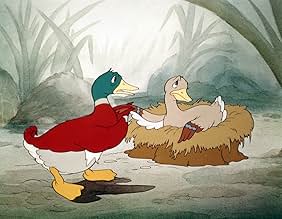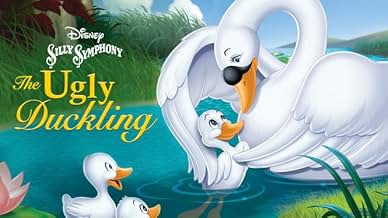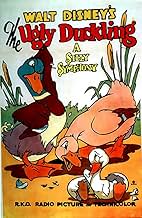IMDb RATING
7.6/10
3.8K
YOUR RATING
A baby duckling is shunned by his family because he is different. He is also rejected by all of the other birds and animals. Finally a mother swan adopts him as one of her brood.A baby duckling is shunned by his family because he is different. He is also rejected by all of the other birds and animals. Finally a mother swan adopts him as one of her brood.A baby duckling is shunned by his family because he is different. He is also rejected by all of the other birds and animals. Finally a mother swan adopts him as one of her brood.
- Won 1 Oscar
- 1 win total
Amanda Cewel
- Mother Duck (speaking)
- (uncredited)
Tom Cotry
- Father Duck (speaking)
- (uncredited)
- Directors
- Writers
- All cast & crew
- Production, box office & more at IMDbPro
Storyline
Did you know
- TriviaThe last Silly Symphony cartoon. Also, the only one to be a remake (of The Ugly Duckling (1931)).
- GoofsWhen the hero is reunited with his family, we discover that he is one of five baby swans. However, for a brief moment, six baby swans appear on screen as they swim around one another before returning to their mother.
- SoundtracksBorn to Ugly Duckling
(uncredited)
Traditional
Performed by studio orchestra
Featured review
For ten years, Walt Disney's talented animators pumped out cartoon after cartoon for his 'Silly Symphonies.' Walt decided it was time to shut down one of animation's most successful series. The final film of the 'Silly Symphonies' was April 1939's "The Ugly Duckling." The series went out with a bang, with the duck short winning the Academy Award for Best Short Subject (Cartoon), the 'Silly Symphonies' eighth Oscar win. The 75-cartoon series proved to be an invaluable testing ground for Disney to create and test new techniques and technologies, resulting in Walt's first feature film, 1938's "Snow White and the Seven Dwarfs."
Disney's animators, led by Jack Cutting and Ham Luske, had completed Hans Christian Andersen's fairy tale cartoon the year before. But Walt elected to hold off its release until he secured a Radio City Music Hall premier during the Easter Week which happened to front-end Fred Astaire and Ginger Rogers' "The Story of Vernon and Irene Castle." The 1939 version of "The Ugly Duckling" was his second telling of the 1843 Andersen story about a newly hatched white duckling who clearly didn't belong to the brood of baby mallard ducks the mother had just delivered. The most recent version was much sadder than its 1931 black-and-white predecessor, which played up the humorous aspects of the tale. But the Oscar-winning 1939 cartoon's ending was more in line with the written Andersen work than the earlier one.
"The Ugly Duckling" of 1939 concluded the 'Silly Symphonies'' storied series beginning in 1929 with "The Skeleton Dance." The string of successive cartoons was intended to be a platform for mainly musically-based animations with very little yapping. Over the course of its ten-year lifespan, the symphonies introduced a variety of innovations in animation, including the first three-strip Technicolor cartoon in 1932's "Flowers and Trees," special effects, more realistic human and animal movements, the multi-plane camera, and on and on. Only the cartoon series 'Tom and Jerry' would achieve the number of Academy Award wins as the 'Silly Symphonies.' After the overwhelming success of "Snow White," Walt decided to concentrate on his ambitious full-length films and his Mickey Mouse shorts. Some say the spirit of the series was carried on by his all-musical animated feature film, 1941's "Fantasia."
Disney's animators, led by Jack Cutting and Ham Luske, had completed Hans Christian Andersen's fairy tale cartoon the year before. But Walt elected to hold off its release until he secured a Radio City Music Hall premier during the Easter Week which happened to front-end Fred Astaire and Ginger Rogers' "The Story of Vernon and Irene Castle." The 1939 version of "The Ugly Duckling" was his second telling of the 1843 Andersen story about a newly hatched white duckling who clearly didn't belong to the brood of baby mallard ducks the mother had just delivered. The most recent version was much sadder than its 1931 black-and-white predecessor, which played up the humorous aspects of the tale. But the Oscar-winning 1939 cartoon's ending was more in line with the written Andersen work than the earlier one.
"The Ugly Duckling" of 1939 concluded the 'Silly Symphonies'' storied series beginning in 1929 with "The Skeleton Dance." The string of successive cartoons was intended to be a platform for mainly musically-based animations with very little yapping. Over the course of its ten-year lifespan, the symphonies introduced a variety of innovations in animation, including the first three-strip Technicolor cartoon in 1932's "Flowers and Trees," special effects, more realistic human and animal movements, the multi-plane camera, and on and on. Only the cartoon series 'Tom and Jerry' would achieve the number of Academy Award wins as the 'Silly Symphonies.' After the overwhelming success of "Snow White," Walt decided to concentrate on his ambitious full-length films and his Mickey Mouse shorts. Some say the spirit of the series was carried on by his all-musical animated feature film, 1941's "Fantasia."
- springfieldrental
- Feb 25, 2024
- Permalink
Details
- Release date
- Country of origin
- Official site
- Language
- Also known as
- Гидке каченя
- Production company
- See more company credits at IMDbPro
- Runtime9 minutes
- Aspect ratio
- 1.37 : 1
Contribute to this page
Suggest an edit or add missing content






















